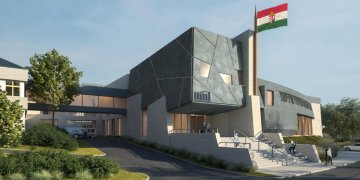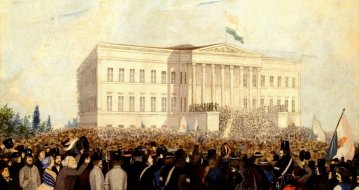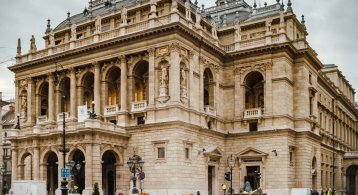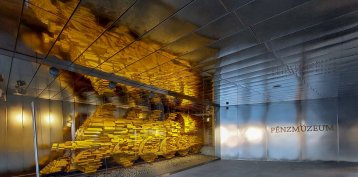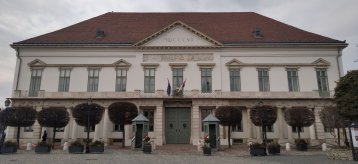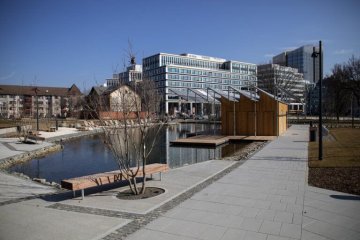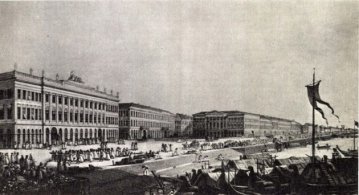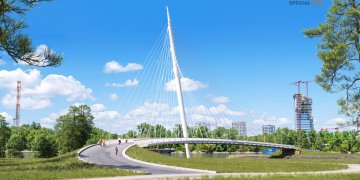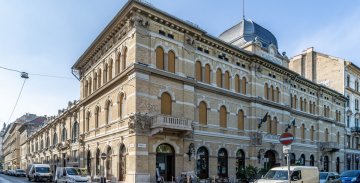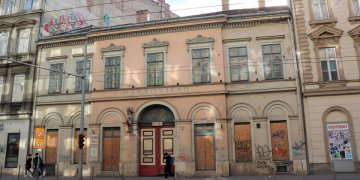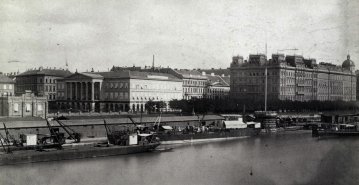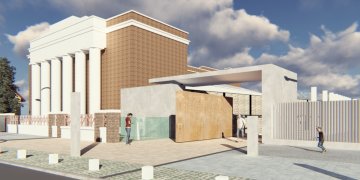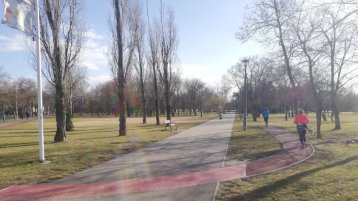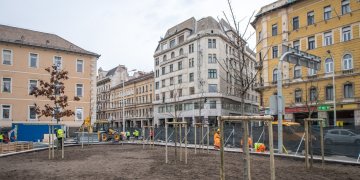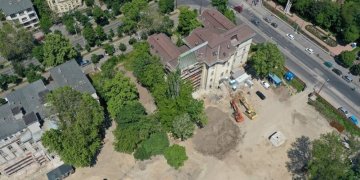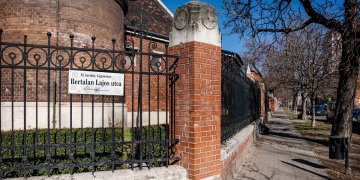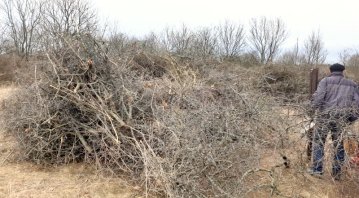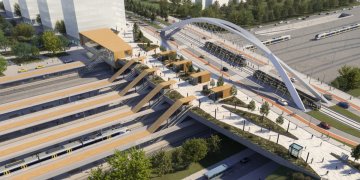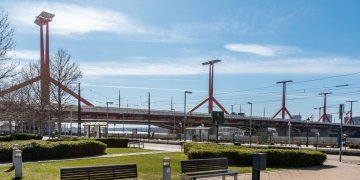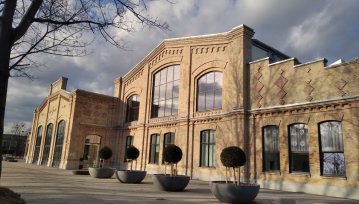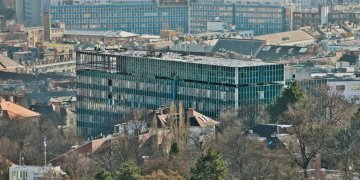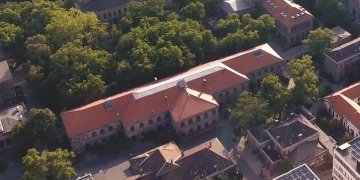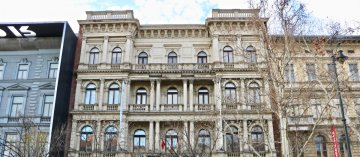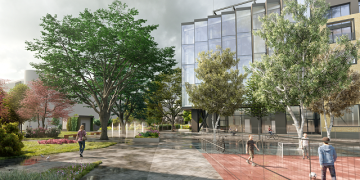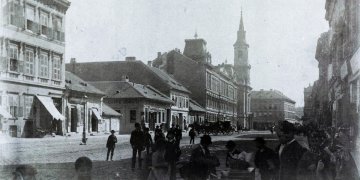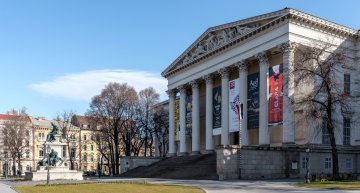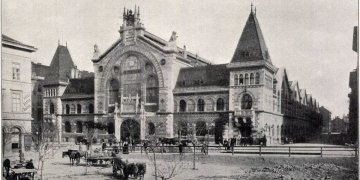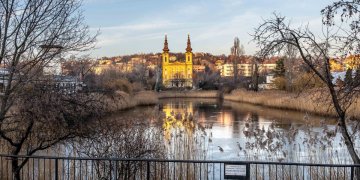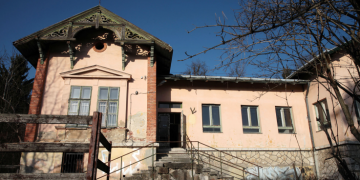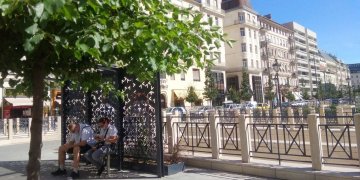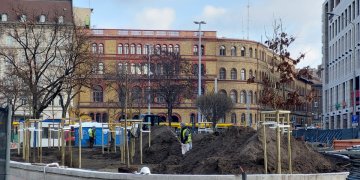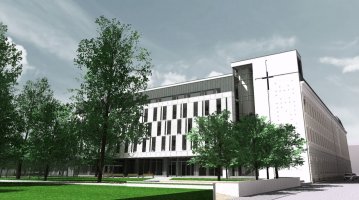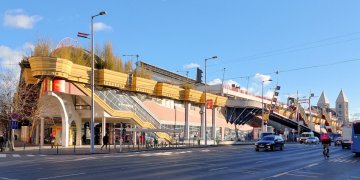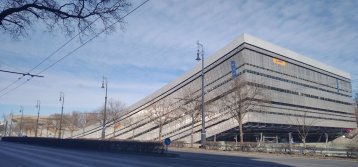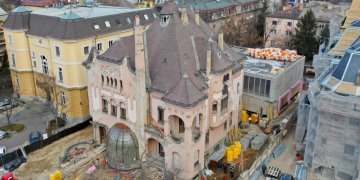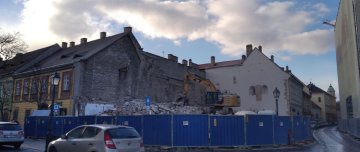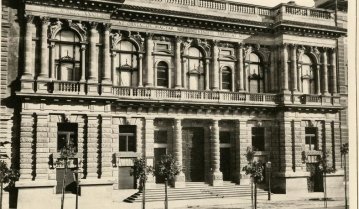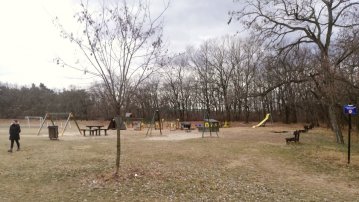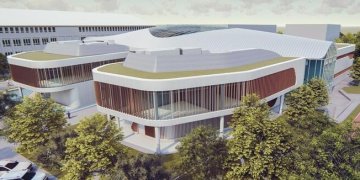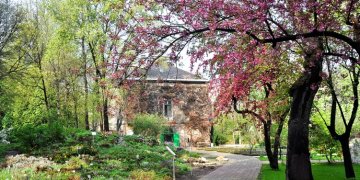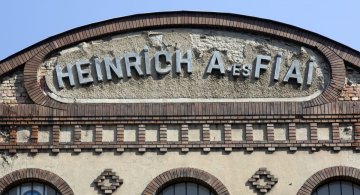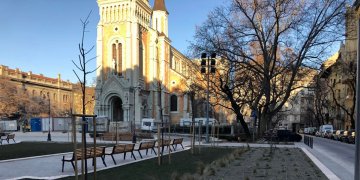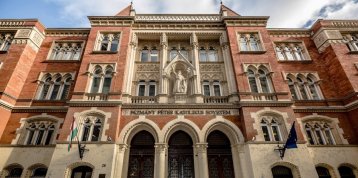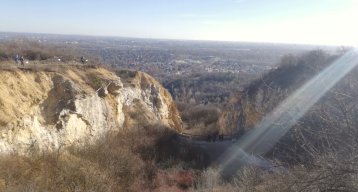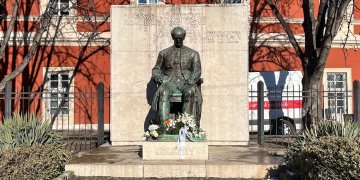 The Bridge Report, which brought a turning point in the history of Budapest
A travel report that changed the history of Pest and Buda, as well as Hungary. The little book contributed to the change of half a thousand years of legal customs and the implementation of an investment of unprecedented size and technical quality. This book was The Bridge Report [Hídjelentés in Hungarian].
The Bridge Report, which brought a turning point in the history of Budapest
A travel report that changed the history of Pest and Buda, as well as Hungary. The little book contributed to the change of half a thousand years of legal customs and the implementation of an investment of unprecedented size and technical quality. This book was The Bridge Report [Hídjelentés in Hungarian].
Search result
The renovation of the building of the Hungarian National Archives in Óbuda may begin soon
March 14, 2022 at 2:00 PM
Development of the Archive's Lángliliom Street warehouse and research room may begin soon. As part of the investment, the building will not only be renovated but also expanded, and the above-ground warehouses equipped with state-of-the-art equipment will be able to store the documents in an appropriate manner and will also have the opportunity to research them.
Sándor Petőfi lived in several places around the National Museum
March 13, 2022 at 11:00 AM
At the beginning of March 1848, the National Museum was one of the most important places in the life of the youth of March, including Sándor Petőfi. Half a decade earlier, Petőfi's life was also connected to this area at several points, as the main locations of his stay in Pest in 1843 and 1844 can be found in the area around the museum. There were several buildings in the area that no longer exist today, where the poet visited for a short time or was just renting accommodation.
After almost 5 years, the renovated Opera House opens its doors today
March 12, 2022 at 2:00 PM
Restoration work began in the building of the Hungarian State Opera in October 2017. The renovation, which lasted for almost 5 years, not only serves to further illuminate one of the architectural gems of Budapest, but it also represents the basic requirements of the 21th century. The history of the construction of the Opera House also proves that these requirements have changed from time to time.
Gold Bars in the deep - The Money Museum opens in the Buda Palace on 15 March
March 11, 2022 at 2:30 PM
One of the most famous buildings of Széll Kálmán Square, the former Buda Postal Palace, has undergone huge changes in recent years. It was purchased by the Hungarian National Bank and began its renovation in 2018. Its exterior has been restored to its golden age, while its interiors have been modernised to accommodate its new functions: most of it has been occupied by the bank's supervisory centre, and the Money Museum was installed in the north wing, which will open on 15 March. However, it was already shown to the press, where Pestbuda could also report from.
The witness of stormy centuries - The renovated Sándor Palace was handed over 20 years ago
March 10, 2022 at 1:00 PM
The Sándor Palace is one of the most important buildings of the Buda Castle. It was built for private purposes in the early 19th century, but only its name suggests it today. Due to its extremely favourable, central location, it was inhabited by the then Prime Minister after the 1867 Compromise, and although this tradition was broken in the decades after World War II, it again played an important role after the turn of the millennium: the Office of the President of the republic moved within the walls.
The 13th district Vizafogó park was handed over
March 9, 2022 at 7:30 PM
On Tuesday, the 13th district Vizafogó park was handed over. The area is called an eco-park, ie during the planning process, special attention was paid to making it ecologically sustainable. A new artificial lake one and a half meters deep has also been created, which also serves as the main visual element.
An impressively rich oeuvre of an architect - József Hild died 155 years ago
March 7, 2022 at 10:00 AM
One of the most famous figures of Hungary in the 16th century was József Hild. He fully deserved his reputation, as the cityscape of Pest, which was booming, was largely determined by his work. However, the unbroken development also caused the destruction of most of his works: many of his inner city buildings were demolished to give way to newer and bigger ones. Fortunately, some of his buildings still stand today and promote the talent of their designer.
The newest bridge in Budapest - An arched footbridge will connect Csepel with Pest
March 6, 2022 at 9:00 AM
The special pedestrian bridge is already under construction in Budapest, which, starting from the athletic stadium of the 9th District, will finally connect the Csepel Island peak to the city's circulation. The structure will connect the island with the Pest side with an arched road, and its recently erected pylon reaches a height of 65 metres.
Nándor Hidegkuti, to the miracle striker of the Golden Team, was born in Óbuda a hundred years ago
March 3, 2022 at 10:00 AM
The excellent footballer of MTK, who became the Olympic champion in 1952 with the legendary Golden Team, started playing football with a rag ball next to the brick factory in Újlak. He had come a long way from Óbuda to world fame, but he managed to achieve what many longed for. Nándor Hidegkuti was born a hundred years ago.
Renovation of the interiors of the Hunyadi Square fairgrounds may begin next year
March 2, 2022 at 2:00 PM
After the external reconstruction, which was completed a few years ago, the renovation of the interiors of the Hunyadi Square fair hall, designed by Czigler Győző, can begin next year. During the works, the subsequent additions will be demolished and the original spatial structure will be restored, a gallery level will be built, but the previously planned underground garage has been removed from the plans.
From a noisy apartment building to the palace of the Academy: János Arany lived in many places in Pest
March 2, 2022 at 9:00 AM
Born 205 years ago, János Arany first saw Pest in 1843, but he only became a permanent resident of the city more than a decade and a half later, in 1860 - and remained so until his death. Several of the poet's former homes in Pest still stand today: the two classicist houses on Üllői Road preserve the memory of the poet, as well as the magnificent palace of the Academy, in which he lived for the rest of his life.
Rising houses - How did Budapest's development into a world city begin?
March 1, 2022 at 9:00 AM
As a result of the Compromise of 1867, dizzying economic development began in Hungary. This was particularly striking in the capital, which in a few decades has evolved from a medium-sized settlement to one of the largest cities in Europe. People flocked to Budapest from the countryside, and more and more houses were built to give the new townspeople a place to live.
Development of the Aquincum Museum has begun - the wonders of ancient monuments are presented in an experiential way
February 28, 2022 at 12:00 PM
The long-awaited development work has begun at the Aquincum Museum, during which a completely new experience wall will be built on the site of the rusty iron fence on Szentendrei Road and a new exhibition will be created to give a glimpse into the lives of the Romans who once lived here. Orsolya Láng, the director of the museum, told Pestbuda exactly what is changing.
Kőbánya can also cause surprises
February 26, 2022 at 10:00 AM
Kőbánya is one of the most deplorable districts in Budapest. Lately, unfortunately, this part of the city has entered the national press in connection with more internet memes or crimes. However, PestBuda undertook to explore the green parks of the 10th District, prepared for the worst. Our journalists were very pleasantly surprised in most places. The street scene, public safety has improved a lot lately in the areas they have explored. Take a look at the pleasant surprises.
Preparations for tree planting in Blaha Lujza Square continue
February 25, 2022 at 6:30 PM
The Budapest Transport Center will plant sixty-one trees soon in the 8th district Blaha Lujza square. Some of them are installed directly on a continuous green surface, others in the cladding using the Stockholm method. This procedure promotes the growth of the roots of urban trees, i.e. improves their living conditions. During the renovation of the square, a water play will be created, among other things, but the construction of the paving and the placement of the furniture will also continue.
No viable idea was received for the tender for the design of the new museum of architecture
February 25, 2022 at 5:00 PM
The jury of the Hungarian Academy of Arts did not find any worthwhile project in the design competition for the design of the Hungarian Museum of Architecture and the Documentation Center for the Protection of Monuments. The new building will be built on the plot complex at the corner of Bajza Street and Városligeti Avenue in the former BM Hospital, once the appropriate tender is available.
History on the map - What do Budapest's street names tell us?
February 25, 2022 at 12:00 PM
Browsing the street names in Budapest, the question may arise: who did the streets and squares we pass through every day get their name from? A recent interactive map that can be browsed by anyone can help you navigate the maze of names: for example, it is clear that real people can be namesakes as well as fictional characters, and some eras, such as the 19th century, gave the city far more names than others. We tried out the interactive map and came across exciting connections.
Twenty-six buildings in the 1st District were declared protected by the capital, most of them built in the Kádár era.
February 24, 2022 at 8:00 PM
Twenty-six 1st District properties, mainly erected between 1956 and 1978, were declared protected by the Budapest General Assembly on Wednesday. These include the main building of the Southern Railway Station, the Hilton Hotel building in Budavár and several residential buildings. The local council of Budapest announced in January that it planned to place nearly one hundred and eighty buildings in Budapest under local protection.
The Ornithological Society held a habitat management on the Tétény Plateau
February 23, 2022 at 8:00 PM
The Hungarian Ornithological and Nature Conservation Association held the habitat management in the Tétény Plateau, one of the most locally protected habitats in the capital, mostly hiding steppe meadows. The site in the 22nd District has recently been cleaned of more than 4,000 tonnes of illegally dumped rubbish, but securing habitat for animal and rare plant species requires ongoing maintenance.
There is no cable car on Gellért Hill - The capital withdraws from the contract
February 23, 2022 at 4:30 PM
The local council of Budapest is withdrawing from the 2009 contract for the construction of the Gellért Hill cable car and the planned bus car park at the lower station. The reason for today's decision of the General Assembly of the Capital City was that more than thirteen years had passed since the entry into force of the contract, without any substantial construction work for the implementation of the investment under the contract having begun at all.
Visual plans for the surroundings of the car-free City Park have been completed
February 23, 2022 at 3:00 PM
The Budapest Development Center presented the transport development study plans of the surroundings of Városliget and the new road-tram overpass on Szegedi road and the related new Rákosrendező station. The aim of the developments is to make the surroundings of Városliget car-free, to close the Kós Károly promenade from traffic and to ban cars from Hősök square.
The government decided to build the Lágymányosi Bridge 30 years ago
February 20, 2022 at 9:00 AM
The government decided on today's Rákóczi Bridge, which for a long time was the youngest Danube bridge in Budapest, exactly 30 years ago, on 20 February 1992. A bridge was planned here as early as the 1960s, so the decision ended a very long, three-decade process. Construction of the bridge could then begin, which was completed in 1995, but the originally planned tram only crossed it in 2015.
Wonder in Kőbánya - We went to the Eiffel Art Studios
February 19, 2022 at 9:00 AM
The Eiffel Art Studios of the Hungarian State Opera is one of the new attractions of the 10th District and of the whole of Budapest. From the former Északi Járműjavító [Northern Locomotiv Workshop] of MÁV, it has become a cultural centre offering colourful programs, while also helping the operation of the Opera. Not only is the Art Studios [Műhelyház in Hungarian, meaning Workshop] interesting because of its complex function, but the recently completed renovation of the hall, originally built in 1886, has also been a great success.
The Ménesi road campus of Corvinus University is being demolished
February 18, 2022 at 6:00 PM
It can be clearly seen from the bank of the Danube in Pest that the Corvinus University Ménesi road campus is being demolished. A new university building will be built in its place, but the area is planned to remain an integral part of the city fabric. In the new building, which is expected to be completed next year, educational and research spaces, a dormitory, professor's apartments, community and representation rooms, as well as rooms suitable for sports and recreation will be established.
The neo-renaissance complex of the University of Veterinary Medicine is being renewed
February 18, 2022 at 2:00 PM
The building complex of the University of Veterinary Medicine, designed by Imre Steindl and decorated with majolica Zsolnay and lead glass by Miksa Róth, will be renewed. The buildings on Rottenbiller Street, completed in 1881 and now home to one of the oldest veterinary training universities in Europe, are being restored to conservation standards. As part of this, the red brick masonry, the roof structures, the windows and the cladding will be restored, but the mechanical and electrical systems of the buildings will also be renewed.
The builder, János Bobula, could live in one of the most beautiful palaces on Andrássy Avenue only for a few years
February 18, 2022 at 10:00 AM
"It is one of the most beautiful buildings on the avenua," said the contemporary press when 62 Andrássy Avenue, formerly known as Bobula Palace, was built in 1882-1883. Maybe it wasn't called that for no reason. The carefully designed building, the list of famous artists of the age, the unique furnishings all suggest that the praise was justified. Moreover, the building faithfully reflected the owner’s financial situation, social status, and architectural views. Although the house is known to everyone today as “a building next to the House of Terror,” Bobula’s Palace deserves much more than that.
Markusovszky Square in Ferencváros can be renewed
February 17, 2022 at 3:30 PM
With resting benches, a new playground and a dog runner you can renew district Markusovszky Square, under which a 120-space underground garage can be built, but fifty trees will also be planted in the area, where the green area will also be increased. A comprehensive concept plan has been prepared for the development of the 9,000-square-meter space, and the visual plans are shown.
The pedestrian underpass and stairs of the Gellért Hill cable car can be built
February 17, 2022 at 1:00 PM
The company responsible for the development received a permit for the construction of the tunnel leading to the station of the future Gellért Hill cable car and the stairs leading to Hegyalja road. With this, the construction of the cable car to the Citadel, which is expected to be completed by the end of 2023, has taken another step closer to completion.
Crowded homes, high mortality: the people of Pest did not have an easy life 150 years ago
February 16, 2022 at 10:00 AM
Today, we cannot imagine the misery of the people of Pest in certain parts of the city before the unification of the city. Nor was it rare, according to statistics from 150 years ago, for several families to live in a single room. Those living in a room crowded with 6 to 10 people died sooner, and the average life expectancy, even in the best parts of downtown, was less than 26 years. PestBuda's article reveals that the misery was great, especially in Ferencváros and Józsefváros, but the situation did not improve in the other districts of the capital for a long time.
In the future, we will also be able to see the exhibitions of the National Museum in the Castle Garden Bazaar
February 15, 2022 at 7:00 PM
From now on, the National Museum will hold at least two exhibitions a year in the Castle Garden Bazaar in co-operation with the Várkapitányság. The exhibition entitled The Hungarian Bride will be held in two locations, in the Museum building and in the Castle Garden Bazaar.
Market halls, which have been handed over 125 years ago, have become the sights of Budapest
February 15, 2022 at 10:00 AM
Modern food supply was one of the important factors in the development of Budapest into a world city. City management found it essential to have indoor, health-friendly stalls, constantly monitored inventory, fixed prices, and fixed opening hours, but little or no open-air markets could meet these conditions. The market halls were designed to regulate all this: the Central Market Hall on Fővám Square, the Rákóczi Square, the Klauzál Square, the Hunyadi Square and the Hold Street Market opened on 15 February 1897, just 125 years ago.
The park of the Bottomless Lake can be named after Mari Törőcsik
February 14, 2022 at 5:00 PM
Although several locations in Újbuda were mentioned, in the vote that has just ended, more than 50 percent of voters have chosen to have the park around the Bottomless Lake named after Mari Törőcsik in the future. The actress, who died in 2021, lived in the 11th district, and in 2016 he was awarded the title of honorary citizen. However, in order for the park around the Bottomless Lake to take the name of Mari Törőcsik, it is still necessary for the decision of the district representative body and the approval of the General Assembly of the Capital City.
The keys to Villa Haggenmacher were handed over, and the building was saved
February 14, 2022 at 2:00 PM
The Hungarian State exercised its right of pre-emption and purchased the 12th district Haggenmacher villa, which was once replaced by the Eye of God inn. The keys were handed over in days. The valuable monument will therefore remain in the public domain and will be used for community purposes after the renovation.
The number of green bus waiters in the city center continues to grow
February 10, 2022 at 6:00 PM
The number of bus waiters planted and planted with plants in the city center will continue to increase after the 5th District locl council continues its greening program. Together with the green waiting places in Hild Square, Szervita Square, Podmaniczky Square and Jászai Mari Square, there will now be eight green bus waiters in the city center.
The renovation of Blaha Lujza Square continues
February 9, 2022 at 4:00 PM
The preparation of the tree planting continues with the 8th district Blaha Lujza square renovation. The root cells have just arrived, and the trees will be planted by the staff of the Budapest Transport Center (BKK) according to the winter weather. The afforestation will be followed by the construction of paving and the placement of space furniture in the square.
The Ráday College, which is being built on the site of the burned dormitory, is ready for construction
February 8, 2022 at 2:00 PM
The new, modern Ráday College of the Károli Gáspár Reformed University is being constructed in the interior of the dormitory, which burned down in tragic conditions in 2019. In the attic of the new building, above the nearly 100-seat dormitory, a chapel will be built, but there will also be a music hall, a roof terrace and the Pál Török Faculty Library. In addition to the restoration, the entire headquarters of the Dunamellék Reformed Diocese will be renewed, as part of which the facade of the old building on Ráday Street will be restored to its 1911 condition.
The Lehel Market Hall building was handed over 20 years ago
February 8, 2022 at 9:30 AM
The Lehel Market Hall building was handed over twenty years ago on the site of the more than 100-year-old Lehel Square Market. The view of the huge five-story hall, which includes more than three hundred business premises, is still very divisive. Thousands of people shop every day in the hall built in the postmodern style. How could it be that even though they wanted to design a hall here as early as the 1900s, they had to wait until the 2000s? That is what PestBuda investigated.
The candelabra of the Chain Bridge regains their pre-World War I appearance
February 7, 2022 at 7:00 PM
According to their appearance in 1914, professionals are restoring and reconstructing the historic, ornate light poles of the Chain Bridge under renovation. A total of four large Széchenyi-era bronze candelabras with three luminaires have survived from the original public lighting columns of the bridge. There is no detailed professional design documentation for the other luminaires that have been lost, so they are reconstructed with the help of contemporary photos, documents and articles.
The new Museum of Ethnography will be handed over in the spring
February 6, 2022 at 9:00 AM
There have been huge changes in City Park recently that are not over yet. The huge car park behind the Kunsthalle (Műcsarnok) has been occupied by an impressive building, the new Museum of Ethnography. It attracts attention not only with its sheer size but also with its shape - all while respecting the park nature of its surroundings. In the spring, anyone will be able to go up to the top of the building, but for the time being, only a few of those interested had the opportunity to do so.
The renovation of the Sipeki Balás villa designed by Ödön Lechner is progressing spectacularly, the new part of the building is ready for construction
February 4, 2022 at 7:00 PM
The complete reconstruction of the Art Nouveau villa, built between 1905 and 1907 on Hermina road, now the headquarters of the Hungarian National Association of the Blind and Visually Impaired (MVGYOSZ), began in the spring of 2021. Part of the work is the refurbishment of the roof, the renovation of the 2,700-square-meter plaster under restoration supervision, but the hall's unique fireplace and stairs, decorated with bluish eosin-glazed tiles, and the artificial stone elements of the façade, are regaining their old splendor. The new part of the building, which was demolished next to the villa and was erected on the site of an outbuilding in the 1970s, has already reached its finished state.
The former diplomatic residence in the Castle was demolished
February 3, 2022 at 9:00 AM
The demolition of the former diplomatic residence, the later Burg Hotel, was completed this week in the Szentháromság Square in Buda Castle, leaving only piles of rubble. The building, designed by György Jánossy and László Laczkovics and completed in 1981 is planned to be replaced by a house that will evoke the exterior of the buildings originally demolished after World War II.
The 150-year-old University of Fine Arts evokes the history of the Old Art Gallery
January 31, 2022 at 3:00 PM
In addition to the newly restored Lotz frescoes of the main building of the Old Art Gallery, the exhibition entitled Space Reservations - The Stories of the Old Art Gallery of the Hungarian University of Fine Arts (MKE) awaits the public from 15 February with classic and contemporary works of art and documents evoking the house's past. The exhibition is part of a series of programs celebrating 150 years of the University.
A lively green area in Budapest: the Péterhalmi Forest and its surroundings
January 29, 2022 at 2:30 PM
From our series of articles presenting the less known green areas of Budapest, the 18th District has been missing until now, although there are also parks and forests worth exploring there. The locals are certainly familiar with all corners of these, but the “Kökintúli” [Outside Kőbánya-Kispest] district also offers experiences for residents of more distant districts. We would like to show that every district has natural values, most of the time unfortunately in spite of very spoiled town planning.
The Jedlik Ányos High School in Csepel is being transformed into an educational institution at European level
January 28, 2022 at 5:00 PM
The foundation stone of the new wing of the Jedlik Ányos Grammar School in Csepel was laid. During the investment, a modern central hall, vocational education wings, a library and pavilions will be built in the Benedictine grammar school in Csepel. The renovation of the secondary school is expected to be completed by October 2023 with the support of the government for HUF 20 billion.
The Herb Garden of Eötvös Loránd University is now part of the Hungarian Depository
January 26, 2022 at 3:30 PM
According to the recent decision of the Hungaricum Committee, the ELTE Herb Garden was admitted to the Hungarian Depository. With this, the botanical garden, founded in 1771, has become one of the “hallways of the Hungaricums” and has become one of the values that is of national importance and is aging our reputation worldwide.
Two Faces of a Building - The Heinrich Courtyard in Józsefváros
January 26, 2022 at 10:30 AM
On the opposite side of Üllői Road, opposite the Museum of Applied Arts, stands a neo-baroque tenement house, built by the iron merchant Ferenc Heinrich. Not far from it, and in the neighbouring Mária Street, lies the long facade of an Art Nouveau warehouse. One would not even think that the two had anything to do with each other, however, both were built by the Heinrich iron merchant family. The latter was completed by 1912, meaning it could begin to be filled with goods a hundred and ten years ago.
The renovated Bakát Square was handed over
January 24, 2022 at 7:00 PM
The renovation of the main square of Ferencváros, Bakáts square, has been completed. The development of the space was initiated in 2016 by the 9th district local council, and by 2018 the plans were born and the implementation was prepared by the experts on behalf of the local council Plants, benches, chess and mill tables and drinking wells were installed on the square formed in the 19th century.
They are looking for a contractor for the new campus of the Pázmány Péter Catholic University
January 24, 2022 at 11:00 AM
The new, unified campus of the Pázmány Péter Catholic University will be located in the Palace District of Józsefváros. As part of the works until 2027, a new campus building will be erected at 26 Szentkirályi Street, and the listed building at 15 Bródy Sándor Street will be renovated, 28-30 Szentkirályi Street Palace will be remodeled and connected to the adjoining university building. An open tender was issued for the construction.
Róka Hill, the capital's Grand Canyon
January 23, 2022 at 9:00 AM
While the statement in the title is, of course, a mere analogy, it is true that the sight of the mining cavities in Róka-hegy [Fox Hill] resembles the American giant valley system. However, most of the hill has been carried away or built up over time, so unfortunately it is not easy to meet a fox in the area. However, what’s left of the mountain and its surroundings after the bumpy past is definitely worth a trip.
The fate of the Kölcsey statue: the Romanians beheaded it, the people of Budapest recreated it
January 22, 2022 at 12:00 PM
The story of Ferenc Kölcsey's first statue in Budapest is very adventurous: the statue of the poet, which was inaugurated in Batthyány Square in 1939 and looked down from a low platform, was able to watch the passers-by from a much more worthy place decades ago. The original of the work in Budapest was inaugurated 125 years ago, hundreds of kilometers from its present location, in Nagykároly. In our article, on the occasion of the Hungarian Culture Day, we present the reasons why the work of art came from Transylvania to Budapest and why it was moved from its original place in Batthyány Square.
 The Bridge Report, which brought a turning point in the history of Budapest
A travel report that changed the history of Pest and Buda, as well as Hungary. The little book contributed to the change of half a thousand years of legal customs and the implementation of an investment of unprecedented size and technical quality. This book was The Bridge Report [Hídjelentés in Hungarian].
The Bridge Report, which brought a turning point in the history of Budapest
A travel report that changed the history of Pest and Buda, as well as Hungary. The little book contributed to the change of half a thousand years of legal customs and the implementation of an investment of unprecedented size and technical quality. This book was The Bridge Report [Hídjelentés in Hungarian].
 Drama on the university wall - The heroic monument was planned 95 years ago
In the constant hustle and bustle of the Egyetem Square in Pest, the students may not even notice the monument that decorates the short section of wall between the church and the central building of ELTE. However, it commemorates their predecessors, the heroes who fought for their country in World War I, and those who heroically helped them. The first design of the dramatically collapsing soldier was born in 1928, ninety-five years ago.
Drama on the university wall - The heroic monument was planned 95 years ago
In the constant hustle and bustle of the Egyetem Square in Pest, the students may not even notice the monument that decorates the short section of wall between the church and the central building of ELTE. However, it commemorates their predecessors, the heroes who fought for their country in World War I, and those who heroically helped them. The first design of the dramatically collapsing soldier was born in 1928, ninety-five years ago.
 A message from the former school: An exhibition in memory of János Neumann was opened at the Fasori Secondary School
An exhibition was opened in János Neumann's former school, the Fasori Lutheran Secondary School, on the occasion of the 120th anniversary of the world-famous mathematician's birth. In the exhibition presenting the former Neumann milieu, paintings, graphics, photos, furniture, and objects tell the story of the art-supporting spirit of the noble bourgeois family at the turn of the century.
A message from the former school: An exhibition in memory of János Neumann was opened at the Fasori Secondary School
An exhibition was opened in János Neumann's former school, the Fasori Lutheran Secondary School, on the occasion of the 120th anniversary of the world-famous mathematician's birth. In the exhibition presenting the former Neumann milieu, paintings, graphics, photos, furniture, and objects tell the story of the art-supporting spirit of the noble bourgeois family at the turn of the century.

